Related Research Articles
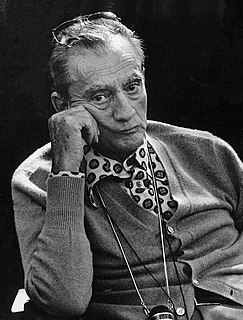
Luchino Visconti di Modrone, Count of Lonate Pozzolo was an Italian filmmaker, stage director, and screenwriter. A major figure of Italian art and culture in the mid-20th century, Visconti was one of the fathers of cinematic neorealism, but later moved towards luxurious, sweeping epics dealing with themes of beauty, decadence, death and European history, especially the decay of the nobility and the bourgeoisie. He was the recipient of many accolades, including the Palme d'Or and the Golden Lion, and many of his works are regarded as highly-influential to future generations of filmmakers.

Italian neorealism, also known as the Golden Age, is a national film movement characterized by stories set amongst the poor and the working class. They are filmed on location, frequently with non-professional actors. They primarily address the difficult economic and moral conditions of post-World War II Italy, representing changes in the Italian psyche and conditions of everyday life, including poverty, oppression, injustice and desperation.

Anna Maria Magnani was an Italian actress. She was known for her explosive acting and earthy, realistic portrayals of characters.

Ossessione is a 1943 Italian film based on the 1934 novel The Postman Always Rings Twice by James M. Cain. Luchino Visconti’s first feature film, it is considered by many to be the first Italian neorealist film, though there is some debate about whether such a categorization is accurate.
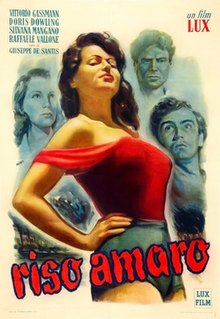
Bitter Rice is a 1949 Italian film made by Lux Film, written and directed by Giuseppe De Santis. Produced by Dino De Laurentiis, starring Silvana Mangano, Raf Vallone, Doris Dowling and Vittorio Gassman, Bitter Rice was a commercial success in Europe and the United States. It was a product of the Italian neorealism style. The Italian title of the film is based on a pun; since the Italian word riso can mean either "rice" or "laughter", riso amaro can be taken to mean either "bitter laughter" or "bitter rice".

Alessandro Blasetti was an Italian film director and screenwriter who influenced Italian neorealism with the film Quattro passi fra le nuvole. Blasetti was one of the leading figures in Italian cinema during the Fascist era. He is sometimes known as the "father of Italian cinema" because of his role in reviving the struggling industry in the late 1920s.
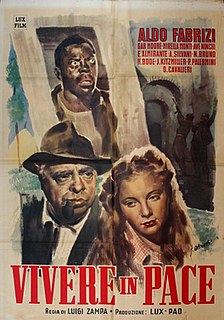
To Live in Peace is a 1947 Italian neorealist comedy-drama war film directed by Luigi Zampa and starring Aldo Fabrizi, John Kitzmiller and Ave Ninchi.

Bellissima is a 1951 Italian neorealist drama film directed by Luchino Visconti and starring Anna Magnani, Walter Chiari and Tecla Scarano. The film is a satire of the postwar Italian film industry, and particularly the dreams of stardom encouraged by the neorealist movement which plucked out ordinary members of the public to appear in productions. Bellissima is the only feature film in Visconti's oeuvre with a predominantly comic tone. It was not a box office success.

Under the Sun of Rome is a 1948 Italian drama film directed by Renato Castellani. It was the first film of Castellani's Italian neorealism trilogy about poor people, followed by È primavera... in 1949 and Cannes Film Festival Palme d'Or winner Two Cents Worth of Hope in 1952.

Amedeo Nazzari was an Italian actor. Nazzari was one of the leading figures of Italian classic cinema, often considered a local variant of the Australian-American star Errol Flynn. Although he emerged as a star during the Fascist era, Nazzari's popularity continued well into the post-war years.

The Elusive Twelve is a 1950 Italian comedy film directed by Mario Mattoli and starring Walter Chiari, Silvana Pampanini and Isa Barzizza. It was shot at the Farnesina Studios of Titanus in Rome. The film's sets were designed by the art director Piero Filippone. It earned 400 million lira at the domestic box office.

I'm the Capataz is a 1951 Italian western-comedy film directed by Giorgio Simonelli and starring Renato Rascel, Silvana Pampanini and Marilyn Buferd.

No Peace Under the Olive Tree is a 1950 Italian neorealist drama film directed by Giuseppe De Santis and starring Raf Vallone, Lucia Bosé and Folco Lulli. It was the director's follow-up to Bitter Rice (1949) which also starred Vallone. It was originally planned to partner him with Silvana Mangano again, but due to her pregnancy she was replaced by Lucia Bosé. Despite the commercial success of Bitter Rice, the Communist De Santis had been stung by left-wing criticism due to American cultural elements included the film which he purposefully excluded from the follow-up. He also included characters who were less ambiguous and concluded with a happy ending, similar to those of Socialist realism.

The Passaguai Family Gets Rich is a 1952 Italian comedy film directed by Aldo Fabrizi and starring Fabrizi, Erminio Macario, Ave Ninchi and Giovanna Ralli. It is the sequel to the hit 1951 film The Passaguai Family.

The Sun Still Rises also known as Outcry is a 1946 Italian neorealist war-drama film directed by Aldo Vergano and starring Elli Parvo, Massimo Serato and Lea Padovani.
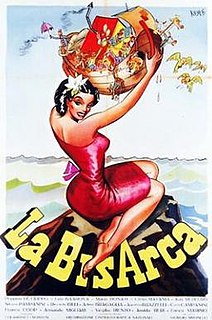
The Transporter is a 1950 Italian comedy science fiction film directed by Giorgio Simonelli and starring Peppino De Filippo, Silvana Pampanini, Lída Baarová and Aroldo Tieri. It is based on a radio program with the same name.

Minerva Film was an Italian film production and distribution company active between 1912 and 1956. It should not be confused with a similarly-named Danish production house.
Oscar Blando (1924–1994) was an Italian film actor. He made his debut after being cast in Renato Castellani's neorealist film Under the Sun of Rome in 1948. The following year he played the lead in Twenty Years, again alongside actress Liliana Mancini. His brief stardom coincided with neorealist attempts to replace the traditional star system by casting more ordinary figures drawn from the public. However he appeared in only a few more productions, in more minor roles.
Stephen Gundle, is a British cultural historian and film scholar. He is a Professor of Film and Television Studies at the University of Warwick. He is best known for his books and articles on Italian culture, politics and the mass media.
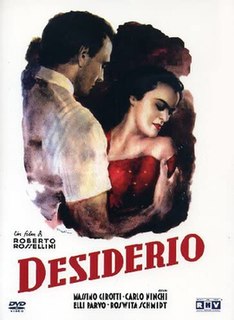
Desire is a 1946 Italian drama film directed by Marcello Pagliero and Roberto Rossellini and starring Massimo Girotti, Elli Parvo and Carlo Ninchi. Interiors were shot at the Farnesina Studios in Rome while location shooting took place around Tagliacozzo in L'Aquila. The film's sets were designed by the art director Virgilio Marchi.